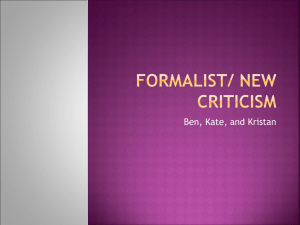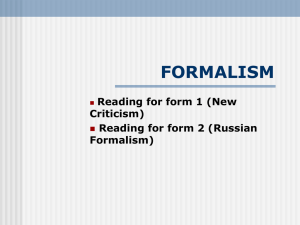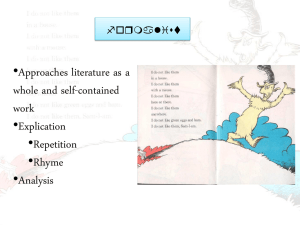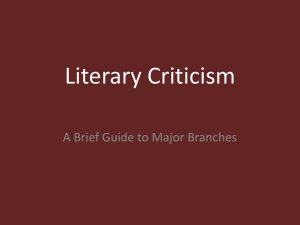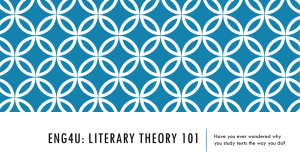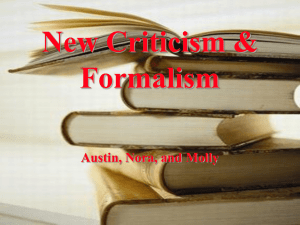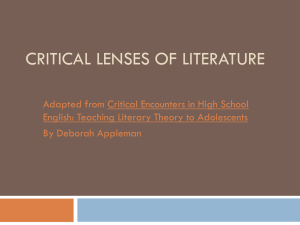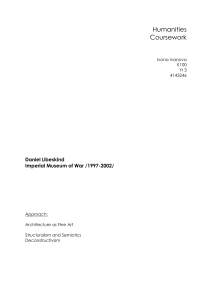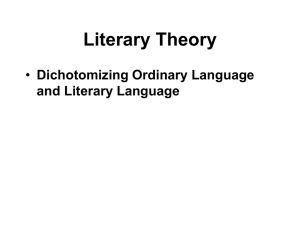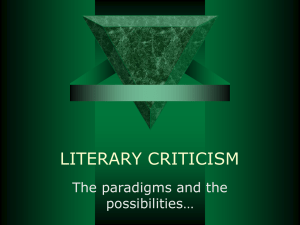File - ENGLISH 102 Fall 14
advertisement
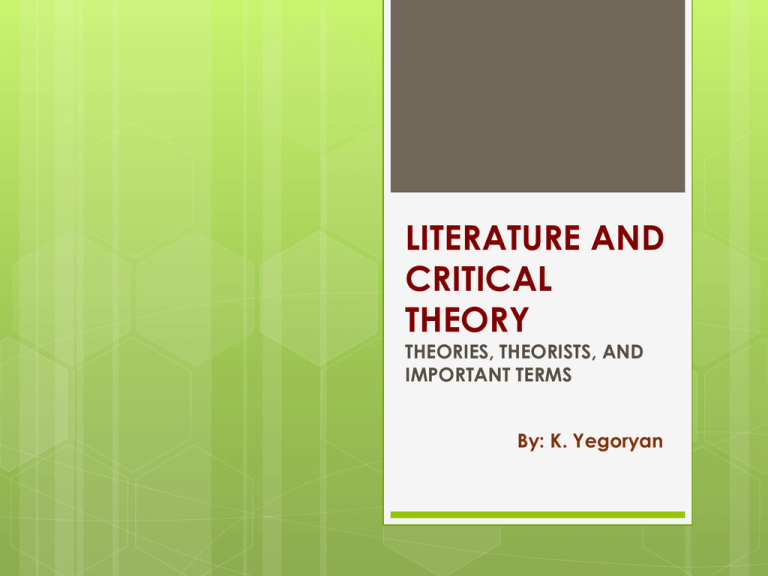
LITERATURE AND
CRITICAL
THEORY
THEORIES, THEORISTS, AND
IMPORTANT TERMS
By: K. Yegoryan
Critical Theory
Greek
{kritikos} = judgment – 18th cent
In Literary studies
Is a form of “hermeneutics”- the
knowledge via interpretation to
understand the meaning of human texts
and symbolic expressions
Critical Theory
As a term developed from “Frankfurt School”
of theorists in 1923 in the meaning of
understanding, criticizing and changing social
thinking
1st defined by Marx in 1937 in the essay
“Traditional and Critical Theory” as a social
theory oriented toward critiquing and
changing society as a whole in contrast to
traditional theory oriented to understanding
and explaining
CRITICAL THEORY
AND LITERATURE
Focuses
on analysis of texts
Originated
in 1960s and has been influenced
by European philosophy and social theories
“A
true critique ought to dwell rather upon
excellences than implications to discover the
concealed beauties of a writer and
communicate to the world such things as are
worth their observations” Joseph Addison
Literary Theory and
Schools of Criticism
Moral
Criticism and Dramatic Construction (~360BC Formalism (1930s)
Structuralism and Semiotics (1920s)
Marxist Criticism (1930s)
Psychoanalytic Criticism (1930s)
Reader-Response Criticism (1960s)
Post-Structuralism, Deconstruction, Postmodernism
(1966)
Post-Colonial Criticism (1990s)
Feminist Criticism (1960s)
Gender Studies and Queer Theory (1970s)
Literary Theory and Schools of Criticism
1. Moral Criticism and Dramatic Construction (~360 BC-present)
Plato
Republic, Plato may have given us the first literary criticism
through the dialog between Socrates and two of his
associates
Aristotle
In Poetics, Aristotle breaks with his teacher (Plato) in the
consideration of art. Aristotle considers poetry and rhetoric
To help authors achieve their objectives, Aristotle developed
elements of organization and methods for writing effective
poetry and drama known as the principles of dramatic
construction
Literary Theory and Schools of Criticism
2. Formalism (1930s-present)
Russian
New
Formalism
Criticism (USA)
Neo-Aristotelianism
Criticism)
(Chicago School of
RUSSIAN FORMALISM and
NEW CRITICISM
Close reading of the work itself
Requires a close focus and analysis of the text
Russian Formalism and New Critics (American
school of thought) claimed:
Meaning exists in the text/on the page
No extra-textual sources to understand
meaning ( no author’s intention, biography,
hist. era should be considered for text’s
meaning)
DEFAMILIZATION
Term by V. Shklovsky ( Russian Formalist)
Instead of seeing Literature as a “reflection” of
the world, the writer must explore new technique
and devices for a renewed perception
( ex. the use of figurative, connotative meaning)
The readers should experience new meanings
and perspectives when seeing the similar in a
different way – “defamiliarized”
3.
Structuralism and Semiotics (1920spresent)
STRUCTUALISM
Method
of Literary interpretation via
structure (human activates are structured
and constructed and so are texts)
Structuralism was affected by:
Linguistics
Social ideology
Psychology/anthropology
Literary analysis
3. Structuralism and Semiotics
(1920s-present)
SEMIOTIC – study of Signs
Studies the signs and types of representation used
by humans to express feelings, ideas, thoughts and
ideologies.
• Study “texts” (can be images, words, or both)
• Text is an assemblage of signs (words, images,
sounds) constructed and interpreted with reference
to conventions of a genre and in particular
medium.
SEMIOTICS
Way
to study/read text and images
•Denotation & Connotation
• Sign =
signifier & signified
– Depends on social, historical and cultural
context
– Depends on context of presentation –
Depends on viewers reception
Hidden
Meanings of famous LOGOS
http://www.youtube.com/watch?v=V_j6ARv10PY&feature=related
Linguistic Structuralism
SEMIOTIC – study of Signs
Ferdinand de Saussure
A Swiss linguistand semiotician whose ideas laid a
foundation for many significant developments both
in linguistics and semiology in the 20th century
Language is based on a – Signifier : the
word, sound,
visual appearance of the word
– Signified: its
meaning,
the underlying concept
Signs are largely arbitrary
Sign doesn't’t carry meaning, the meaning comes
from the relation of difference (A is A because it’s not
B) and nor reference
Charles Sanders Peirce
An American philosopher, logician, known for his contributions in
semiotics and as "the father of pragmatism".
SIGN and MEANING
There are three relationships between
a sign (referent) and its meaning
• Icon (resemblance to actual thing)
• Index
(connection of facts: often cause-effect)
• Symbol (depend on how interpreted)
Representation= symbol: to stand for, to suggest an idea, visual
image, belief, action
Icon
Index
Symbol
SEMIOTICS
Semiotics: the study of signs
http://www.youtube.com/watch?v=rEgxTKUP_WI
Semiotics Of The Tie
http://www.youtube.com/watch?v=qeefWS8YrDw
Roland Barthes
A French literary theorist, philosopher,
linguist, critic, and semiotician.
‘The Death of the Author’
Meaning exists not only in
production but reception
The signifier “I” is a ‘shifter’; that moves from
one speaker to the other speaker as each
lays claim to it
Linguistically, the author is never more than
the instance writing’
Semiotics
Barthes’ MYTH
Hidden set of rules and conventions through
which meanings, which are specific to certain
groups, are made to seem universal and given for
a whole society
Is a form of language that creates an alternative
reality; is a tool to excess the reality
It converts history into nature. And the task of the
mytholographer is to rediscover the element of
history that motivates the myth, to elicit what is
specific to a given time and place, asking what
interests are served by the naturalization of
particular convictions and values.
‘Myth Construction’
Innoculation:
Acknowledging a small detail
to mask larger problem
Prevention of History: Removing an object
from its place and reality and thus its freedom
Identification: sameness and the destruction
of difference
Neither-Norism: balance created by
weighting 2 sides against each other (nihilism)
MEANING and NIHILISM
Nihilism- philosophical doctrine suggesting
the negation of one or more meaningful
aspects of life
Moral Nihilists- assert that morality doesn’t
inherently exist, and that any established
moral values are invented/ brought out by a
plan
Nihilism is also associated with Anomia:
general mood of despair at the perceived
pointlessness of existence that one may
develop realizing there are no necessary
norms, rules, and laws.
4.Marxist Criticism and Social
Ideology (1930s-present)
one
a
type of symbolic system among others
set of doctrines, beliefs, or ideas that form
the basis of a political, economic, or other
system which attempts to put the experience
of the world into some order. The result in
Marxist thought is the distortion of reality to
maintain authority over it.
Karl Marx
German philosopher, economist,sociologist,
“Ruling Class/Ruling Ideas”
Ideology is the ideas of the ruling class
that are in any epoch the ruling idea;
the class which is the ruling material force
of society is at the same time its ruling
intellectual force
Louis Althusser
a philosopher, known as “structural Marxist” was
critical of many aspects of structuralism.
ISA and RSA
ISA- Ideological State Apparatuses
RSA Repressive State Apparatuses
In order to produce its productive power, state
applies control through ideologies/ rituals (ISA)
and if needed through repression/violence (RSA)
Althusser’s Interpellation
A
process by which ideology pre-defines
individuals/ constructs them
(recreation/birth)
Secondary status of subject as mere effect of
social relation
Idealized future
Identifiable characters
AT & T Ad with Interpellation
http://www.youtube.com/watch?v=TZb0avfQme8
